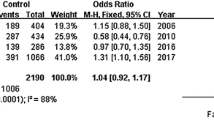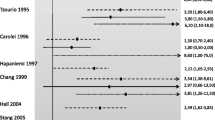Abstract
Migraine is a painful and debilitating disorder with a significant genetic component. Steroid hormones, in particular estrogen, have long been considered to play a role in migraine, as variations in hormone levels are associated with migraine onset in many sufferers of the disorder. Steroid hormones mediate their activity via hormone receptors, which have a wide tissue distribution. Estrogen receptors have been localized to the brain in regions considered to be involved in migraine pathogenesis. Hence it is possible that genetic variation in the estrogen receptor gene may play a role in migraine susceptibility. This study thus examined the estrogen receptor 1 (ESRα) gene for a potential role in migraine pathogenesis and susceptibility. A population-based cohort of 224 migraine sufferers and 224 matched controls were genotyped for the G594A polymorphism located in exon 8 of the ESR1 gene. Statistical analysis indicated a significant difference between migraineurs and non-migraineurs in both the allele frequencies (P=0.003) and genotype distributions (P=0.008) in this sample. An independent follow-up study was then undertaken using this marker in an additional population-based cohort of 260 migraine sufferers and 260 matched controls. This resulted in a significant association between the two groups with regard to allele frequencies (P=8×10−6) and genotype distributions (P=4×10−5). Our findings support the hypothesis that genetic variation in hormone receptors, in particular the ESR1 gene, may play a role in migraine.

Similar content being viewed by others
References
Terwindt G, Haan J, Ophoff R, Frants R, Ferrari M (1997) The quest for migraine genes. Curr Opin Neurol 10:221–225
Gardner K (1999) The genetic basis of migraine: how much do we know? Can J Neurol Sci 26 [Suppl 3]:S37–S43
Stewart WF, Schechter A, Rasmussen BK (1994) Migraine prevalence: a review of population-based studies. Neurology 44 [Suppl 4]:S17–S23
Headache Classification Committee of the International Headache Society (1988) Classification and diagnostic criteria for headache disorders, cranial neuralgias and facial pain. Cephalgia 8 [Suppl 7]:20
Ferrari MD (1998) Migraine. Lancet 351:1043–1051
Moskowitz MA (1991) The visceral organ brain: implications for the pathophysiology of vascular head pain. Neurology 41:182–186
MacGregor EA (1996) “Menstrual” migraine: towards a definition. Cephalalgia 16:11–21
MacGregor EA (1997) Menstruation, sex hormones, and migraine. Neurol Clin 15:125–141
Massiou H, MacGregor EA (2000) Evolution and treatment of migraine with oral contraceptives. Cephalgia 20:170–174
Kelly MJ, Levin ER (2001) Rapid actions of plasma membrane estrogen receptors. Trends Endocrinol Metab 12:152–156
Cenni B, Picard D (1999) Ligand-independent activation of steroid receptors: new roles for old players. Trends Endocrinol Metab 10:41–46
Iwase H, Greenman JM, Barnes DM, Hodgson S, Bobrow L, Mathew CG (1996) Sequence variants of the estrogen receptor gene found in breast cancer patients with ER negative and progesterone receptor positive tumours. Cancer Lett 108:179–184
Weizmann Institute of Science GeneCards, available
Osterlund MK, Grandien K, Keller E, Hurd YL (2000) The human brain has distinct regional expression patterns of estrogen receptor α mRNA isoforms derived from alternative promoters. J Neurochem 75:1390–1398
Bethea CL, Lu NZ, Gundlah C, Streicher JM (2002) Diverse actions of ovarian steroids in the serotonin neural system. Front Neuroendocrinol 23:41–100
Luconi M, Forti G, Baldi E (2002) Genomic and non-genomic effects of estrogens: molecular mechanisms of action and clinical implications for male reproduction. J Steroid Biochem Mol Biol 80:369–381
Chen Z, Yuhanna I, Galcheva-Gargova Z, Karas R, Mendelsohn M, Shaul P (1999) Estrogen receptor α mediates the nongenomic activation of endothelial nitric oxide synthase by estrogen. J Clin Invest 103:401–406
National Centre for Biotechnology Information, availablehttp://www.ncbi.nlm.nih.gov/
Roodi N, Bailey LR, Kao WY, Verrier CS, Yee CJ, Dupont WD, Parl FF (1995) Estrogen receptor gene analysis in estrogen receptor positive and receptor negative primary breast cancer. J Natl Cancer Inst 87:446–451
Curran JE, Lea RA, Rutherford S, Weinstein SR, Griffiths LR (2001) Association of estrogen receptor and glucocorticoid receptor gene polymorphisms with sporadic breast cancer. Int J Cancer 95:271–275
Lea RA, Dohy A, Jordan K, Quinlan S, Brimage PJ, Griffiths LR (2000) Evidence for allelic association of the dopamine β-hydroxylase gene (DBH) with susceptibility to typical migraine. Neurogenetics 3:35–40
Johnson MP, Lea RA, Curtain RP, Macmillan JC, Griffiths LR (2003) An investigation of the 5-HT2C receptor gene as a migraine candidate gene. Am J Med Genet 117B:86–89
Miller SA, Dykes DD, Plensky HF (1988) A simple salting out procedure for extracting DNA from human nucleated cells. Nucleic Acids Res 16:1215
Mantel N, Haenszel W (1959) Statistical aspects of the analysis of data from retrospective studies of disease. J Natl Cancer Inst 22:719–748
Haan J, Terwindt GM, Ferrari MD (1997) Genetics of migraine. Neurol Clin 15:43–59
Peroutka SJ (2002) Sympathetic look at genetic basis of migraine. Headache 42:378–381
Xu J, Wiesch DG, Meyers DA (1998) Genetics of complex human diseases: genome screening, association studies and fine mapping. Clin Exp Allergy 28:1–5
Risch N, Merikangas K (1996) The future of genetic studies of complex human diseases. Science 273:1516–1517
Silberstein SD, Merriam GR (2000) Physiology of the menstrual cycle. Cepahalgia 20:148–154
Marcus DA (1995) Interrelationships of neurochemicals, estrogen, and recurring headache. Pain 62:129–139
Sohrabji F, Miranda RC, Toran-Allerand CD (1994) Estrogen differentially regulates estrogen and nerve growth factor receptor mRNAs in adult sensory neurons. J Neurosci 14:459–471
Bereiter DA, Stanford LR, Barker DJ (1980) Hormone-induced enlargement of receptive fields in trigeminal mechanoreceptive neurons. II. Possible mechanisms. Brain Res 184:411–423
Edvinsson L (1999) On migraine pathophysiology. In: Edvinsson L (ed). Migraine and headache pathophysiology. Dunitz, London, pp 3–5
Johnson BD, Zheng W, Korach KS, Scheuer T, Catterall WA, Rubanyi GM (1997) Increased expression of the cardiac L-type calcium channel in estrogen receptor-deficient mice. J Gen Physiol 110:135–140
Mermelstein PG, Becker JB, Surmeier DJ (1996) Estradiol reduces calcium currents in rat neostriatal neurons via a membrane receptor. J Neurosci 16:595–604
Acknowledgements
This work was supported by funding from NHMRC and Griffith University. Dr. Rod Lea is supported by an NHMRC (C.J. Martin) Fellowship. Experiments comply with the current laws in Australia.
Author information
Authors and Affiliations
Corresponding author
Rights and permissions
About this article
Cite this article
Colson, N.J., Lea, R.A., Quinlan, S. et al. The estrogen receptor 1 G594A polymorphism is associated with migraine susceptibility in two independent case/control groups. Neurogenetics 5, 129–133 (2004). https://doi.org/10.1007/s10048-004-0181-4
Received:
Accepted:
Published:
Issue Date:
DOI: https://doi.org/10.1007/s10048-004-0181-4




